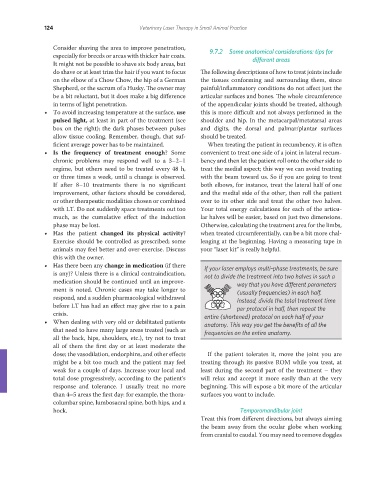Page 138 - Veterinary Laser Therapy in Small Animal Practice
P. 138
124 Veterinary Laser Therapy in Small Animal Practice
Consider shaving the area to improve penetration, 9.7.2 Some anatomical considerations: tips for
especially for breeds or areas with thicker hair coats. different areas
It might not be possible to shave six body areas, but
do shave or at least trim the hair if you want to focus The following descriptions of how to treat joints include
on the elbow of a Chow Chow, the hip of a German the tissues conforming and surrounding them, since
Shepherd, or the sacrum of a Husky. The owner may painful/inflammatory conditions do not affect just the
be a bit reluctant, but it does make a big difference articular surfaces and bones. The whole circumference
in terms of light penetration. of the appendicular joints should be treated, although
• To avoid increasing temperature at the surface, use this is more difficult and not always performed in the
pulsed light, at least in part of the treatment (see shoulder and hip. In the metacarpal/metatarsal areas
box on the right); the dark phases between pulses and digits, the dorsal and palmar/plantar surfaces
allow tissue cooling. Remember, though, that suf- should be treated.
ficient average power has to be maintained. When treating the patient in recumbency, it is often
• Is the frequency of treatment enough? Some convenient to treat one side of a joint in lateral recum-
chronic problems may respond well to a 3–2–1 bency and then let the patient roll onto the other side to
regime, but others need to be treated every 48 h, treat the medial aspect; this way we can avoid treating
or three times a week, until a change is observed. with the beam toward us. So if you are going to treat
If after 8–10 treatments there is no significant both elbows, for instance, treat the lateral half of one
improvement, other factors should be considered, and the medial side of the other, then roll the patient
or other therapeutic modalities chosen or combined over to its other side and treat the other two halves.
with LT. Do not suddenly space treatments out too Your total energy calculations for each of the articu-
much, as the cumulative effect of the induction lar halves will be easier, based on just two dimensions.
phase may be lost. Otherwise, calculating the treatment area for the limbs,
• Has the patient changed its physical activity? when treated circumferentially, can be a bit more chal-
Exercise should be controlled as prescribed; some lenging at the beginning. Having a measuring tape in
animals may feel better and over-exercise. Discuss your “laser kit” is really helpful.
this with the owner.
• Has there been any change in medication (if there If your laser employs multi-phase treatments, be sure
is any)? Unless there is a clinical contraindication, not to divide the treatment into two halves in such a
medication should be continued until an improve- way that you have different parameters
ment is noted. Chronic cases may take longer to (usually frequencies) in each half.
respond, and a sudden pharmacological withdrawal Instead, divide the total treatment time
before LT has had an effect may give rise to a pain per protocol in half, then repeat the
crisis. entire (shortened) protocol on each half of your
• When dealing with very old or debilitated patients anatomy. This way you get the benefits of all the
that need to have many large areas treated (such as frequencies on the entire anatomy.
all the back, hips, shoulders, etc.), try not to treat
all of them the first day or at least moderate the
dose; the vasodilation, endorphins, and other effects If the patient tolerates it, move the joint you are
might be a bit too much and the patient may feel treating through its passive ROM while you treat, at
weak for a couple of days. Increase your local and least during the second part of the treatment – they
total dose progressively, according to the patient’s will relax and accept it more easily than at the very
response and tolerance. I usually treat no more beginning. This will expose a bit more of the articular
than 4–5 areas the first day: for example, the thora- surfaces you want to include.
columbar spine, lumbosacral spine, both hips, and a
hock. Temporomandibular joint
Treat this from different directions, but always aiming
the beam away from the ocular globe when working
from cranial to caudal. You may need to remove doggles
REDONDO PRINT (4-COL BLEED).indd 124 08/08/2019 09:48

